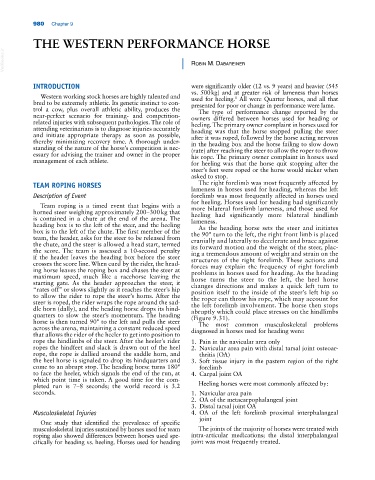Page 1014 - Adams and Stashak's Lameness in Horses, 7th Edition
P. 1014
980 Chapter 9
THE WESTERN PERFORMANCE HORSE
VetBooks.ir Robin m. dabaReineR
INTRODUCTION were significantly older (12 vs. 9 years) and heavier (545
vs. 500 kg) and at greater risk of lameness than horses
Western working stock horses are highly talented and used for heeling. All were Quarter horses, and all that
1
bred to be extremely athletic. Its genetic instinct to con presented for poor or change in performance were lame.
trol a cow, plus overall athletic ability, produces the The type of performance change reported by the
near‐perfect scenario for training‐ and competition‐ owners differed between horses used for heading or
related injuries with subsequent pathologies. The role of heeling. The primary owner complaint in horses used for
attending veterinarians is to diagnose injuries accurately heading was that the horse stopped pulling the steer
and initiate appropriate therapy as soon as possible, after it was roped, followed by the horse acting nervous
thereby minimizing recovery time. A thorough under in the heading box and the horse failing to slow down
standing of the nature of the horse’s competition is nec (rate) after reaching the steer to allow the roper to throw
essary for advising the trainer and owner in the proper his rope. The primary owner complaint in horses used
management of each athlete. for heeling was that the horse quit stopping after the
steer’s feet were roped or the horse would nicker when
asked to stop.
TEAM ROPING HORSES The right forelimb was most frequently affected by
lameness in horses used for heading, whereas the left
Description of Event forelimb was most frequently affected in horses used
Team roping is a timed event that begins with a for heeling. Horses used for heading had significantly
more bilateral forelimb lameness, and those used for
horned steer weighing approximately 200–300 kg that heeling had significantly more bilateral hindlimb
is contained in a chute at the end of the arena. The lameness.
heading box is to the left of the steer, and the heeling As the heading horse sets the steer and initiates
box is to the left of the chute. The first member of the the 90° turn to the left, the right front limb is placed
team, the header, asks for the steer to be released from cranially and laterally to decelerate and brace against
the chute, and the steer is allowed a head start, termed its forward motion and the weight of the steer, plac
the score. The team is assessed a 10‐second penalty ing a tremendous amount of weight and strain on the
if the header leaves the heading box before the steer structures of the right forelimb. These actions and
crosses the score line. When cued by the rider, the head forces may explain the frequency of right forelimb
ing horse leaves the roping box and chases the steer at problems in horses used for heading. As the heading
maximum speed, much like a racehorse leaving the horse turns the steer to the left, the heel horse
starting gate. As the header approaches the steer, it changes directions and makes a quick left turn to
“rates off” or slows slightly as it reaches the steer’s hip position itself to the inside of the steer’s left hip so
to allow the rider to rope the steer’s horns. After the the roper can throw his rope, which may account for
steer is roped, the rider wraps the rope around the sad the left forelimb involvement. The horse then stops
dle horn (dally), and the heading horse drops its hind abruptly which could place stresses on the hindlimbs
quarters to slow the steer’s momentum. The heading (Figure 9.31).
horse is then turned 90° to the left and pulls the steer The most common musculoskeletal problems
across the arena, maintaining a constant reduced speed diagnosed in horses used for heading were:
that allows the rider of the heeler to get into position to
rope the hindlimbs of the steer. After the heeler’s rider 1. Pain in the navicular area only
ropes the hindfeet and slack is drawn out of the heel 2. Navicular area pain with distal tarsal joint osteoar
rope, the rope is dallied around the saddle horn, and thritis (OA)
the heel horse is signaled to drop its hindquarters and 3. Soft tissue injury in the pastern region of the right
come to an abrupt stop. The heading horse turns 180° forelimb
to face the heeler, which signals the end of the run, at 4. Carpal joint OA
which point time is taken. A good time for the com
pleted run is 7–8 seconds; the world record is 3.2 Heeling horses were most commonly affected by:
seconds. 1. Navicular area pain
2. OA of the metacarpophalangeal joint
3. Distal tarsal joint OA
Musculoskeletal Injuries 4. OA of the left forelimb proximal interphalangeal
joint
One study that identified the prevalence of specific
musculoskeletal injuries sustained by horses used for team The joints of the majority of horses were treated with
roping also showed differences between horses used spe intra‐articular medications; the distal interphalangeal
cifically for heading vs. heeling. Horses used for heading joint was most frequently treated.

